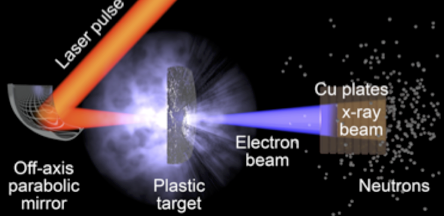Tabletop particle accelerators and their applications
A dramatic outcome of laser-plasma interaction in the relativistic regime is the emission of intense radiation from the plasma. In different experimental scenarios, multi-GeV electrons, multi-MeV ions, intense x-rays, positrons, and neutrons have been observed. These results along with the small dimensions of CPA lasers earned them their nickname "Tabletop Accelerators."
Research of these compact radiation sources is conducted on various target types e.g.: gas, cluster media, solids and micro-structured targets. However, the irradiation of solid foils achieves by far the most versatile control over properties of the emitted radiation.
Despite the extensive efforts invested in these studies, nearly all laser-foil interaction experiments to-date are conducted in a "single-shot" mode, i.e. on a very slow shot rate.
Laser-solid target interaction at a high repetition rate

We developed a uniqe laser-solid irradiation system capable of constant operation at a rate of 10 Hz (shown in the picture above). The setup consists of a computer-controlled target manipulation system capable of bringing fresh targets to the focus of the laser at an appropriate rate with sub-wavelength accuracy. The targets are fabricated with micromachining methods and mounted on silicon wafers. This novel target delivery system has two particular advantages over those used in current experiments:
- It enables the collection of data which incorporates a large number of shots with target parameters changed in small increments
- It enables experiments and applications that benefit from a high overall radiation dose or increased statistics
Laser-neutron generation

We developed a novel laser-based method for producing intense short bursts on neutrons
[Pomerantz I, et al., Ultrashort pulsed neutron source. Phys. Rev. Lett 2014, 113:184801].
The scheme is depicted above. The laser pulse is focused onto a thin plastic target.
Energy deposited in the target from low-level light arriving ~100 ns prior to the arrival of the main pulse is
sufficient to turn the target into an exploding plume of plasma.
The interaction of the main laser pulse with the plasma accelerates electrons and forms a high-energy electron
jet that co-propagates with the laser beam. The electron jet impinges on a secondary copper target,
positioned downstream to the plastic target. The electrons are stopped in the copper and radiate
high-energy (Bremsstrahlung) gamma rays.
These gamma rays interact with the copper nuclei and release photo-neutrons.